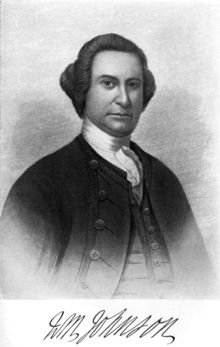Johnson, Sir William (Pioneer & Soldier)
William Johnson 1715-1774

William Johnson
was a pioneer and a soldier,
an Anglo Irish officer of the British Empire and friend to the Mohawk.
He was born in County Meath in 1715, the eldest son of Christopher Johnson of Smithstown and Ann Warren of Warrenstown.
As a young man he emigrated to the province of New York to manage an estate purchased by his uncle Admiral Peter Warren which was located amidst the Mohawk, one of the Six nations of the Iroquois League. The Mohawk population had dwindled to 580.
He became known as "benevolent dictator" amongst the Native Americans because of his fairness and industry. He learned the Mohawk language, and he was trusted by them to argue their cause with the British.
His industry prevented the "Six Nations" from going over to the French during the Anglo French wars. Thus he was made a major general in 1755. He was awarded a baronetcy and a grant of £5,000, after he defeated the French at the Battle of Lake George.
He was also granted 100,000 acres on the north bank of the Mohawk River for his services against the French in Canada in 1760. It was here, in 1762, he founded the city of Johnstown and established a free school for white and Mohawk children there. The following year he built his house here, calling it Johnson Hall. (below)

He had numerous children by several European and Native American women and provided for them all.
He introduced a large number of Irishmen to settle in the district and opened it up for the development of agriculture. He made his fortune through trade.
He died from a stroke in Johnstown Hall in July 1774 after delivering an address to the Indian Council of the Six Nations. Over 2000 attended his funeral and he is buried beneath the altar of St. John's Anglican Church in Johnstown, which he had built.
His home Johnstown Hall is today a National Historic Landmark.
Source: White Savage - William Johnson and the Invention of America, Fintan O'Toole 2005
*******
Smithstown House
Smithstown House is located near Dunshaughlin, just off the Navan Dublin road. There was a house there in the 1830s but the current Smithstown House was erected in the mid nineteenth century. An entrance avenue was created to the main road for the new house.
William Johnson, a descendant of the O'Neill's of Tyrone, settled at Smithstown. William Johnson's son, Christopher, married Anne Warren of nearby Warrenstown. The Johnsons were tenants of the Warrens. William Johnson was born at Smithstown in 1715, the son of Christopher Johnson and Anne Warren. William left Smithstown in 1738 to go to the Mohawk Valley bringing with him twelve local families to settle on the Warren lands there. William Johnson was a pivotal figure in British colonial and early Native American fortunes. The story of William Johnson is told in Fintan O'Toole's book White Savage. Another relative, Guy Johnson, also distiniguished himself in America. Guy was supposed to be William's nephew.
The Logan family succeeded the Johnsons at Smithstown. In his 1851 will James Logan left an annuity for the Roman Catholic parochial school of Dunsany. Walter Logan held the house and 294 acres from the Earl of Fingal in 1854. In 1876 Nicholas Logan held 294 acres in county Meath. Nicholas R. Logan, of Smithstown, also held 440 acres in Westmeath. The Logan family left Smithstown in the late 1800s and emigrated to Buenos Aires.
In 1901 R.J. Logan owned the house but it was resided in by Annie Eliza Wilkinson. In 1911 Lucy Sophie Chaytor was residing in the house and also owned the property. The house had twenty five rooms, eleven windows to the front and eighteen outbuildings. In 1946 the property came into the ownership of Major Bruce Ogilvy, a brother to the Earl of Airlie. The Major had been equerry to Edward VIII, who abdicated in 1936. The Beggan family purchased the house in 1956 and operated it as a stud and cattle farm. Paddy Beggan, Smithstown House, was a member of Meath's first ever team to take part in an All-Ireland senior football final in Croke Park. The Royal Meath Equestrian Centre is now located at Smithstown House.
Source: meath-roots.com